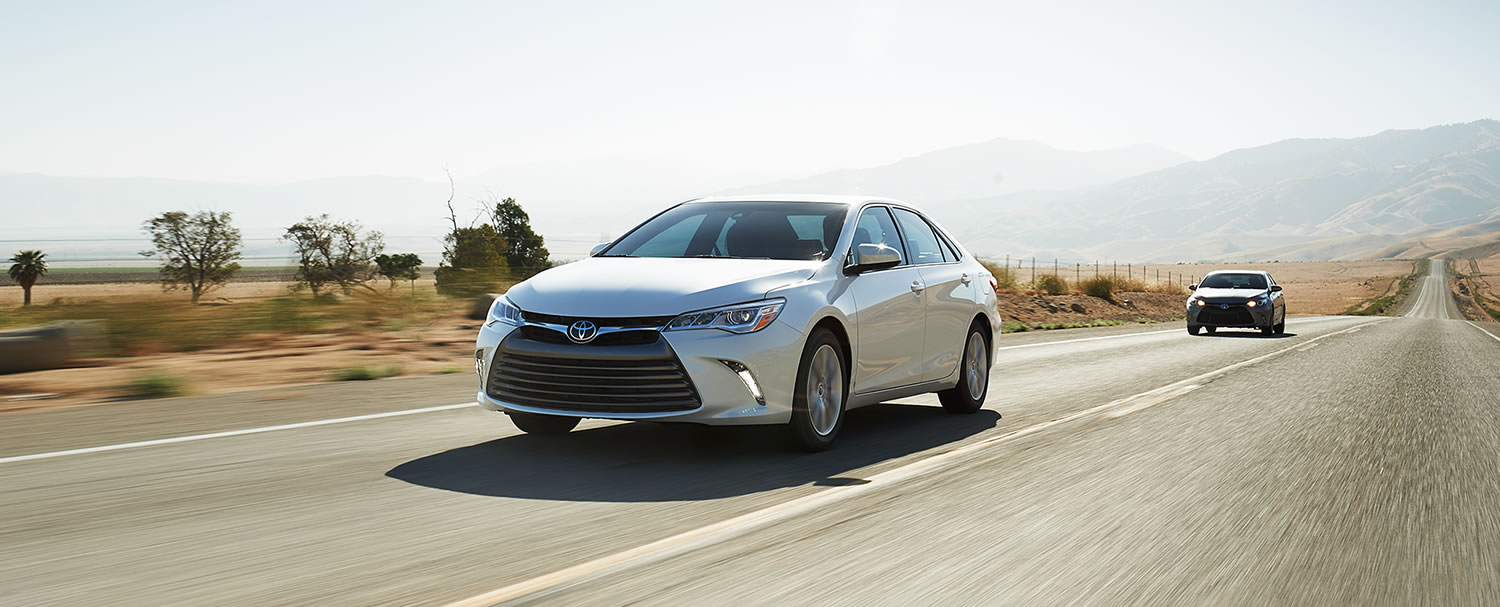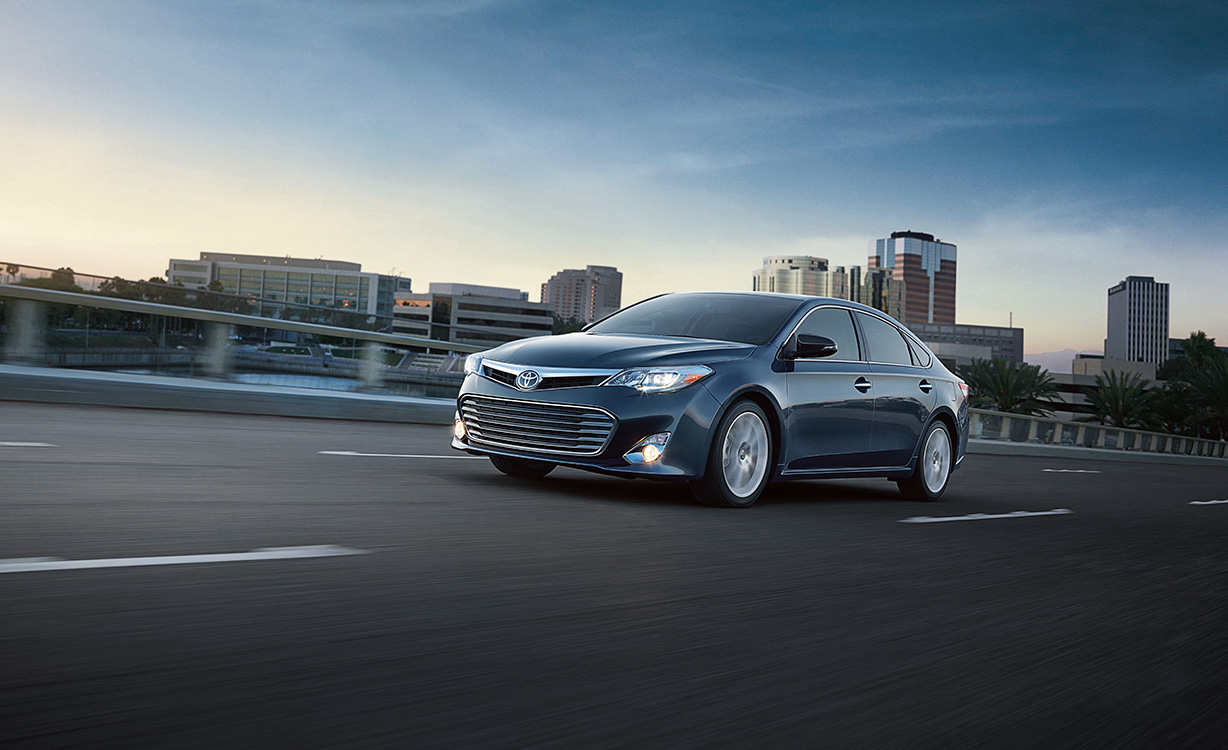

Executive wheels: Toyota twinsies
Jeff Rundles //June 4, 2015//


2015 TOYOTA CAMRY CAMRY XLE V6 SEDAN & AVALON HYBRID 4-DR LIMITED
For many years, I wrote that so many cars on the American market – American brands, Japanese brands, Korean brands, even European brands – looked like Toyotas, and that this fact was no accident. Toyota had the reputation everywhere for quality and durability and all of those other car makers were trying to cash in on the cache, if only superficially.
But when the new 2015 Toyota Camry was delivered to me I walked out to greet the driver and I wondered why he had brought me a BMW. That was my distinct impression – that this Camry, and a week later its nearly identical twin, the 2015 Toyota Avalon, looked just like a BMW 3 or 5 Series sedan. It dawned on me during the two weeks I spent with these two cars that it was also no accident that they looked like BMWs. Everybody copied Toyota for almost two decades to glom onto its quality reputation; today, however, everything is morphing into the look of BMW for a different reason: BMW has clearly established itself as the styling leader.
Toyota certainly doesn’t need to copy BMW in all of the other measurements – performance and technology come to mind; the famous Japanese carmaker does its best to mimic BMW in its luxury line, Lexus. Toyota has plenty of performance and technology, but it isn’t pushing envelopes here. However, the new Toyota BMW-ish styling, I believe came about because the line, after being the sales leader for many, many years, was starting to give off the impression that it was stodgy.
Indeed, Camry was the leading sedan in US sales from about 1997 until 2011, but it has been surpassed by, of all things, the Nissan Altima, though for the life of me I can’t understand why. Styling perhaps; Nissan is nothing if not stylish and a style envelope-pusher. But they couldn’t go after Nissan styling because A) the Altima drew its styling cues from the Camry to begin with, and B) when you are Toyota you don’t make any public nods in the way of an upstart like Nissan.
In any case, I drove my BMW-looking Camry for a week, loved it almost completely, and I was eager to get the Avalon to see how the Toyota basics played out in a larger, more-luxury model. Turns out I was disappointed in the Avalon, or rather Toyota – not because I didn’t love the Avalon, which I did, but because it just felt and looked exactly like the Camry, so much so that I sometimes forgot I wasn’t driving the Camry.
The exteriors seemed identical, there were some interior flourish upgrades on the Avalon, and there was a skosh more leg room in the Avalon’s rear seat (although both were way beyond ample in that department). And I kept thinking, “Why would you make the same car in two different, and differently priced nameplates?” I told my son that while I liked them both, I would forego that $5,000 to $6,000 base price premium for an Avalon with the same engine and get virtually the same car, the same experience, for less money.
On the Camry, I said that I loved it almost completely, and my minor complaint is an easy fix: the car came in a silver metallic paint, and they paired it with a drab, grey leather interior that gave the impression that it was purchased by my grandmother. Personally, if I bought the Camry – and I would, for sure – I would get it in red or black, something splashier than gray, and I would pair it with black or tan interior leather. With this done, my only complaint would be wiped out.
The Camry is quite easy to drive, and quite pleasurable. This one came with the V6, a 3.5-liter powerplant that put out some 268 hp that felt like more than that, a lot more. Yet, it has great mileage: 21 mpg city/31 mpg highway. This car was quick – off the line, on the highway when I needed to change lanes and pass, up in the hills, whatever. Coupled with a 6-speed auto tranny that is very smooth and responsive, and then married to an excellent suspension and ride, this Camry is very maneuverable, fun to drive. It corners like a dream, cruises well – this would be an excellent road-trip vehicle.
Other plusses: As I mentioned earlier, the leg room in the rear seating area is great, and the trunk is huge – a four golf-bagger. Also, the technology is all here – all the hookups for modern equipment, Bluetooth phone, et cetera, et cetera. I especially like the Toyota keyless entry; just walk up to the car and when you touch the handle it unlocks, and when you leave you just touch the handle and it locks, Couldn’t be easier. What is also easy is the touch screen for the radio and apps control (offers very little driving distraction), and separate and easy climate controls.
The base price of the Camry XLE (there are several trims, and some with a smaller engine) is $31,370, and that includes a ton of nice standards. On this one they added, for $515, Safety Connect, which includes stolen vehicle locator, emergency and roadside assistance, and automatic collision notification (a subscription service; one year trial included). They also added blind spot monitoring and rear cross-traffic alert, for $500, and for $805 an upgraded JBL sound system, with all the tech you’d want (and all the sound you can handle), and another $750 for a Technology Package that offers pre-collision system, lane departure alert, dynamic radar cruise control, and automatic high beams. There are a few other small things, plus destination charges, and the bottom line is $36,543. If there’s a better car like this on the market for that price, I haven’t seen it.
The 2015 Avalon is all that, done in a slightly less appealing format. The Avalon they sent me has Toyota’s excellent hybrid system, which is also avaiable on the Camry. This vehicle features a 2.5-liter 4-bager gas engine coupled with a 105-kW electric motor system that is rated at 200 hp. Funny, though, I never noticed the difference. The Avalon Hybrid was very quick in all conditions and I often had to remind myself that it wasn’t the Camry in all respects including power and performance.
So the big difference is the mileage: the Avalon Hybrid is rated at 40 mpg city/39 mpg highway – the more I drove it, the more I didn’t notice the gas level declining. How wonderful. Plus, I feel as though I still need to mention this: except for it being unbelievably quiet when starting (because the gas engine isn’t on), you’d never know it was a hybrid. It operates like any other car – charges itself – so you can just reap the benefits of the higher gas mileage without any plug-in nonsense, or any loss of power and performance.
And, of course, since it is a hybrid they have to put the batteries somewhere, they put them behind the rear seat. This compromises the trunk space. You can still get a couple of golf bags in there, but you have to make some accommodation for the electric batteries.
The Avalon Hybrid they sent me, the Limited, carried a base price of $41,700. They only added, for $1,950, a Technology package similar to the Camry’s, and of course destination charges, so the bottom line was $44,475.
I loved them both. But since you can also get a Camry with the same hybrid system, and the Camry is marginally less expensive while being nearly identical, I just don’t get the idea behind the Avalon. Make mine Camry.
RATINGS:
2105 TOYOTA CAMRY XLE V-6: 4 WHEELS OUT OF 4 PLUS THE SPARE.
2015 TOYOTA AVALON HYVBRID: 3 ½ WHEELS OUT OF 4.
























